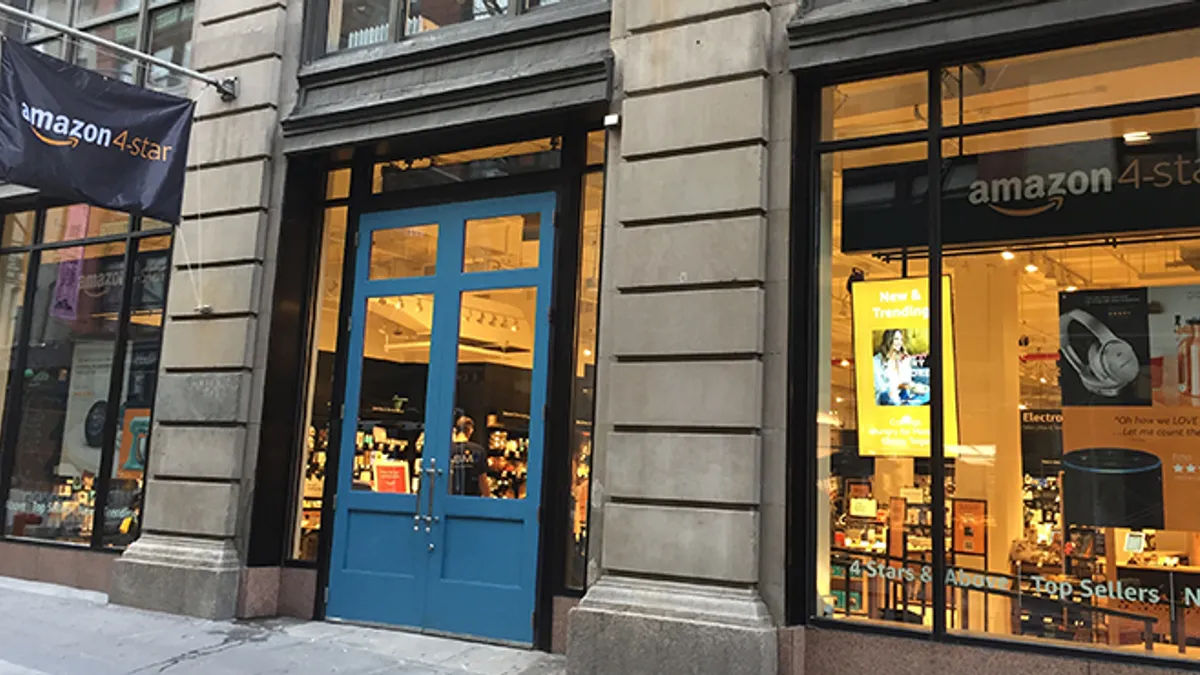Dive Brief:
-
Amazon on Friday touted the benefits of its stores to smaller brands and retailers, saying that "more than 50,000 small and medium-sized businesses exceeded $500,000 in sales in Amazon's stores worldwide, and nearly 200,000 surpassed $100,000 in sales in our stores."
-
The number of such businesses "eclipsing $1 million in sales in Amazon's stores worldwide grew by 20 percent in 2018," according to an Amazon press release. Millions of them globally from more than 130 different countries are selling in Amazon's stores and more than a million are based in the U.S. and come from every state, according to the release.
-
Third-party sales on the company's marketplace "are growing at a faster rate than first-party sales on Amazon and across retailers in the U.S.," Amazon also said, noting that over the holidays, "sales by small and medium-sized businesses outpaced its retail business sales in Amazon's stores worldwide."
Dive Insight:
Count Amazon among the former e-commerce pure-plays that are finding brick and mortar to be crucial to their marketing and sales.
The opportunity for small- and medium-sized businesses in Amazon's stores is "immense," according to Ryan Berger, Senior Partner at influencer marketing platform HYPR. "Just today, the store in downtown NYC was packed, with consumers touching, experiencing, and sharing products all around the store, taking pictures of items they have never seen before, and sharing those pictures with friends and on social media. With the power of Instagram, the impact makes lots of sense, and it is no wonder that Amazon has provided a platform for these small businesses to showcase their products."
But, some note, it could be that Amazon is including its online marketplace and vendors to its Whole Foods grocery chain to create a buzz around its "stores," considering that it runs few bookstores and that its Amazon Go chain — while growing — remains largely experimental.
"Based on reading Amazon's report, I believe that they're using the term 'stores' very loosely to include the online marketplace of third-party sellers which would support a lot of their stats," Chris Perry, vice president at Edge by Ascential, told Retail Dive in an email. "It would be interesting to know whether they're including Whole Foods stores which would have a lot of small and medium business suppliers."
The company has amplified its benefits to smaller retailers before. In September, Amazon launched Amazon Storefronts, which employs videos and "stories" to help customers to shop from nearly 20,000 small and medium-sized businesses that sell exclusively on its site. It may be feeling pressure to do that, as the retail giant is increasingly under fire for disrupting local retail. Amazon on Friday once again touted its Small Business Impact Report, saying that small and medium-sized businesses selling on Amazon have created more than 900,000 jobs worldwide, and that last year more than 300,000 U.S.-based small and medium-sized businesses started selling on Amazon.
Certainly, third parties are growing in importance to Amazon. The percentage of goods sold on the site by those sellers reached 53% in the third quarter, CFO Brian Olsavsky said on an October conference call. Their importance was evident in Amazon's move last year to merge its marketplace and retail groups.
In the process, the company has boosted its gross margins and gross profit, and that will only continue, according to Instinet analysts, who said in a report last fall that the e-commerce giant is morphing into more of a mall than a retailer. Amazon is also relying more on its marketplace to sell apparel, and by itself offers fewer Adidas and Nike products than Macy's despite Nike's tie-up with the e-commerce giant, according to a report from Coresight Research. The e-retailer has good reason to push third-party sales on its platform, in light of the ability it confers to let it kick back and collect fulfillment and storage fees while sellers grapple with orders and inventory.















